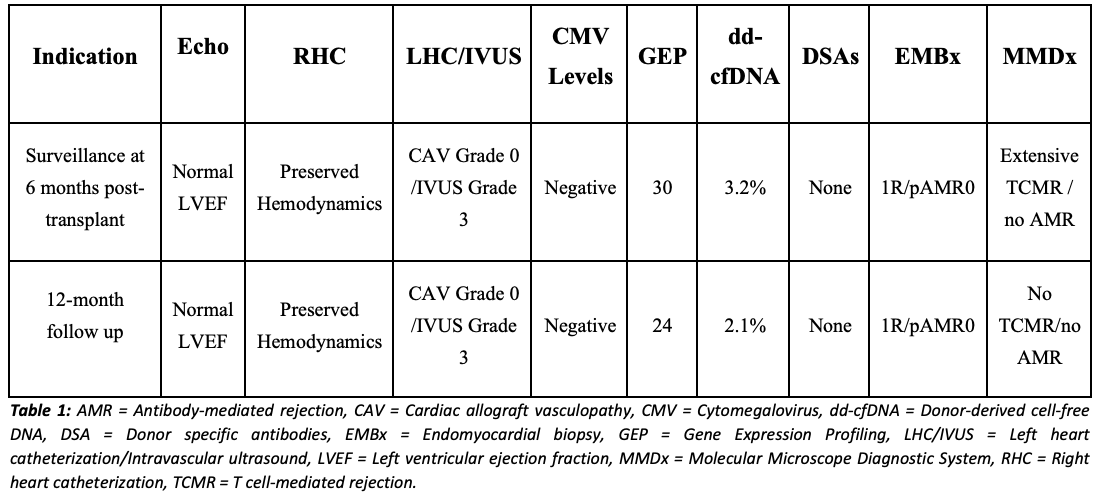A Real-World Analysis with the Molecular Microscope Diagnostic System in Dual-Organ Transplant Recipients
1Cardiology, Baylor University Medical Center at Dallas, Dallas, TX, 2Baylor University Medical Center at Dallas, Dallas, TX, 3Advanced Heart Failure & Transplant Cardiology, Baylor University Medical Center at Dallas, Dallas, TX, 4Transplant Cardiology and Mechanical Support/Heart Failure, Baylor University Medical Center at Dallas, Dallas, TX
Meeting: 2022 American Transplant Congress
Abstract number: 1137
Keywords: Rejection
Topic: Clinical Science » Heart » 63 - Heart and VADs: All Topics
Session Information
Session Time: 7:00pm-8:00pm
 Presentation Time: 7:00pm-8:00pm
Presentation Time: 7:00pm-8:00pm
Location: Hynes Halls C & D
*Purpose: The Molecular Microscope Diagnostic System (MMDx) analyzes ribonucleic acid transcripts to provide sophisticated differentiation amongst T-cell mediated rejection (TCMR), antibody mediated rejection (AMR), injury and healthy tissue. However, little is known about its performance in dual organ transplant recipients.
*Methods: Endomyocardial biopsies (EMBx) and corresponding MMDx, results were collected from 12 adult heart transplant patients combined with either kidney (n=10) or liver (n=2) from our single center and were retrospectively reviewed. Rejection by EMB was defined as TCMR greater than 1R and/or AMR greater than pAMR0 utilizing ISHLT grading schematics.
*Results: A total of 16 specimen results from 12 patients were reviewed. There were concordant findings between EMBx and MMDx in 94% (15/16) of the specimens. Of these 16 specimens, 15 were negative for rejection on both tests. One patient’s heart/liver transplant results were discordant – EMBx negative for rejection and MMDx suggestive of TCMR (Table 1). After verifying compliance to medications, the patient’s immunosuppression was optimized with the addition of sirolimus following a multi-disciplinary discussion of all contradictory clinical and diagnostic data. One year follow up revealed no further TCMR detected by MMDx and EMBx remained negative for rejection as well.
*Conclusions: Conclusion: MMDx is a tool to potentially provide added accuracy in patient diagnoses in combination with other diagnostic data. In cases of discordant results, all data should be analyzed in a multi-disciplinary format to determine patient management. Larger studies are needed to validate these preliminary findings.
To cite this abstract in AMA style:
Blair JM, Zyl JVan, Milligan GP, McKean SM, Patel R, Hall SA, Alam A. A Real-World Analysis with the Molecular Microscope Diagnostic System in Dual-Organ Transplant Recipients [abstract]. Am J Transplant. 2022; 22 (suppl 3). https://atcmeetingabstracts.com/abstract/a-real-world-analysis-with-the-molecular-microscope-diagnostic-system-in-dual-organ-transplant-recipients/. Accessed January 7, 2026.« Back to 2022 American Transplant Congress

